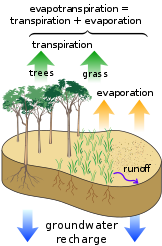Ollas and evotranspiration
Definition of a plant's need for irrigation
Most of the water a plant needs is the volume of water it loses through evapotranspiration each day.
Indeed, the quantities of water stored in a plant and those used by its metabolism are insignificant compared to those that the plant must absorb due to losses by transpiration.
We can therefore consider that the water needs of plants correspond to losses by evapotranspiration.
The actual evapotranspiration of a plant is defined based on the potential evapotranspiration of the area, the type of plant and the stage of development of the plant.
Thus, the rates of potential evapotranspiration can vary enormously according to the climates and the times of the year.
In dry areas, the rate of potential evapotranspiration from a simple lawn varies between 6 and 9 mm of water per day and m², while in temperate areas it is around 1 to 2 mm per day and m².
(*) For vegetable crops or fruit trees, which have higher water requirements, higher values must be considered.
(*) Ch. Riou and GJ Dubois, First measurements of potential evapotranspiration in the Republic of Chad, 1966

Calculation of evotranspiration
There are various methods and software to estimate the water needs of a plant, more or less precisely. However, irrigation needs can be estimated in a simplified way by first measuring the evaporation rate of the area using an evaporation pan, Ebac.
Then a correction coefficient of 0.66 is applied to the evaporation rate obtained to obtain the potential evapotranspiration rate of a plant cover.
To best take into account the stage of development of the plant cover in question, divide the correction coefficient by 2 (i.e. 0.66 /2=0.33) and multiply it by (1+C), where C, is the fraction of soil covered by plants (0 if sowing, 1 if the soil is completely covered).
This gives the formula I = (0.33 x (1+C) x Ebac
I = Need for irrigation
Ebac = the rate of evaporation measured in the tank for 24 h
C = the rate of soil cover by plants

